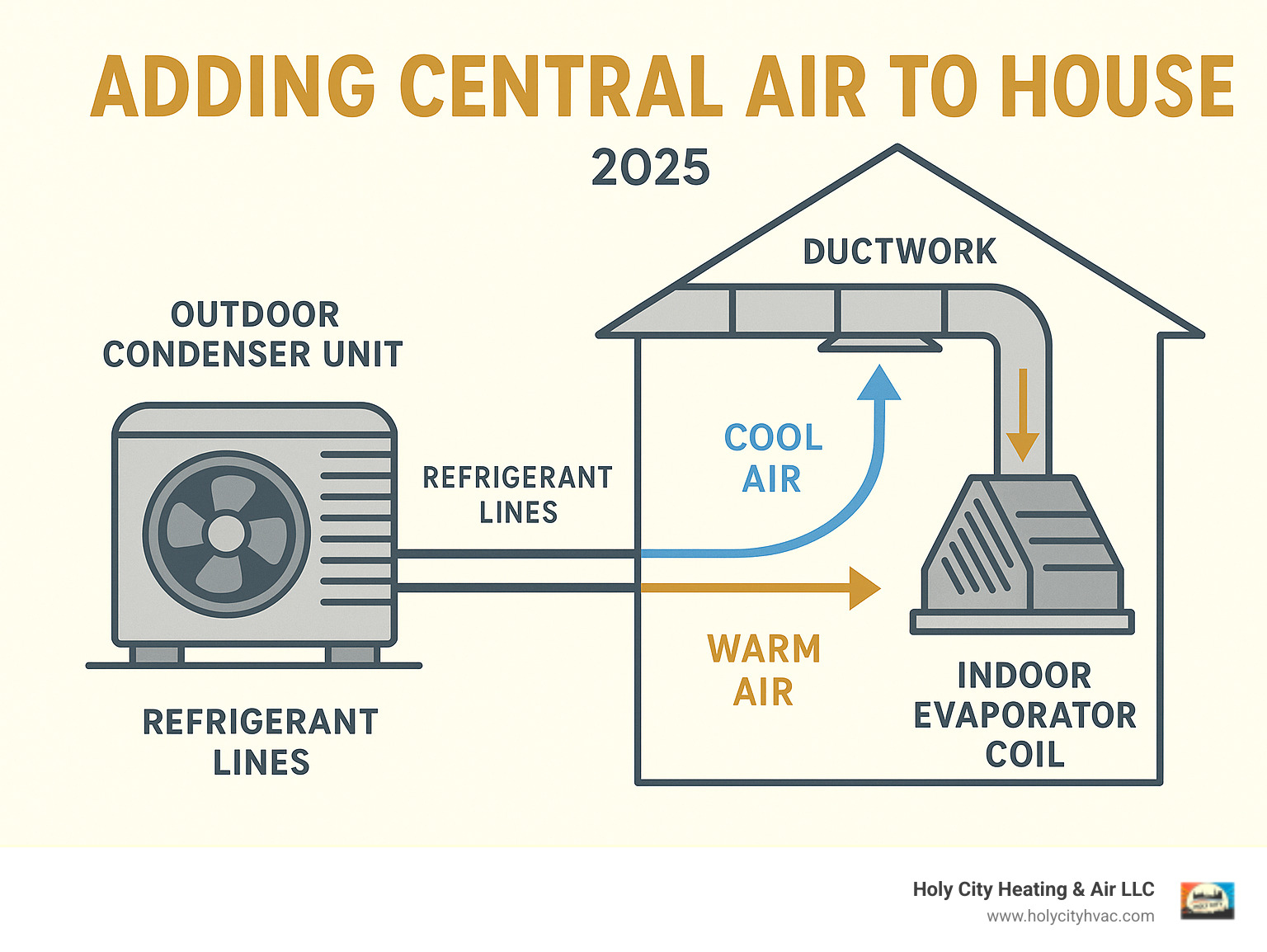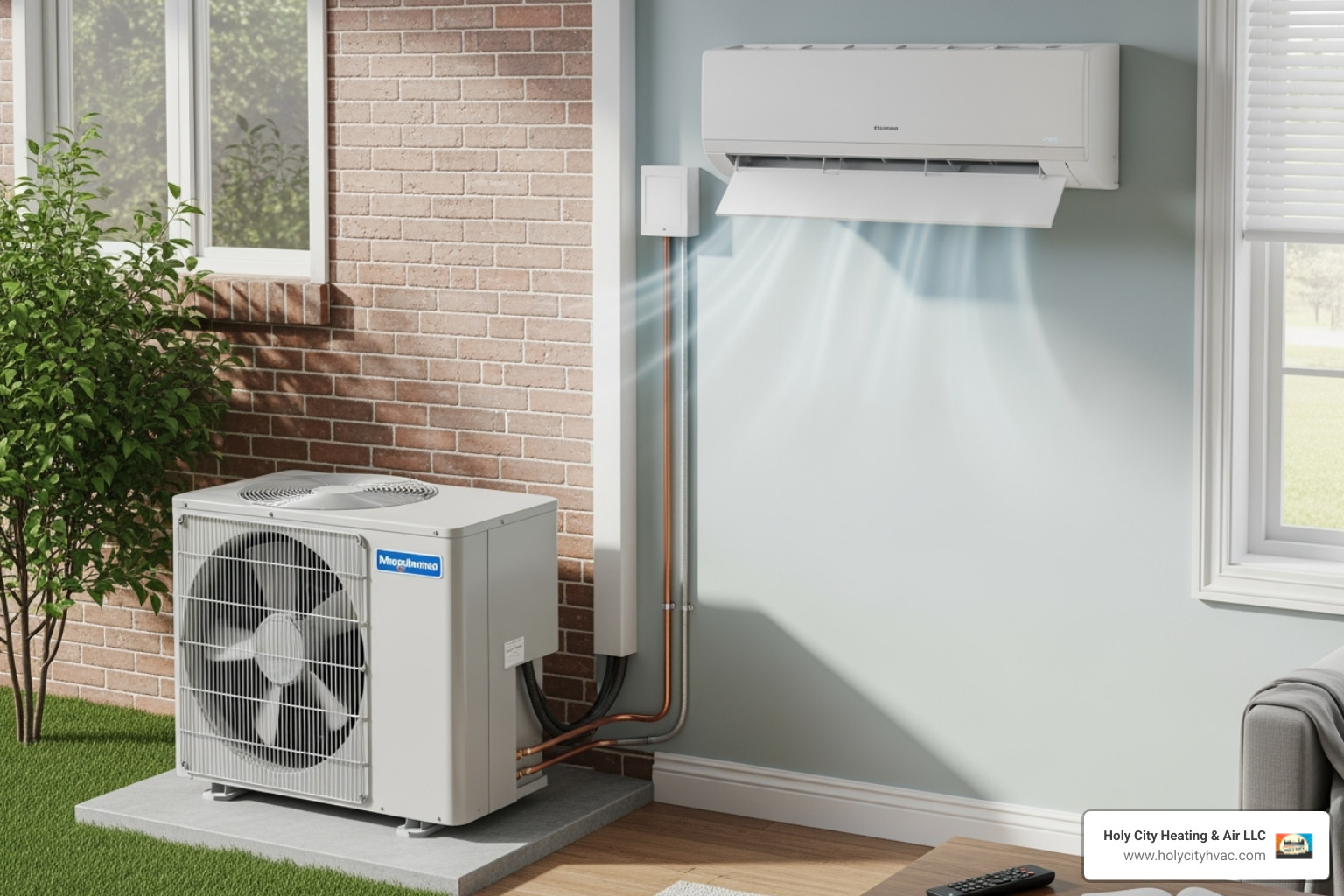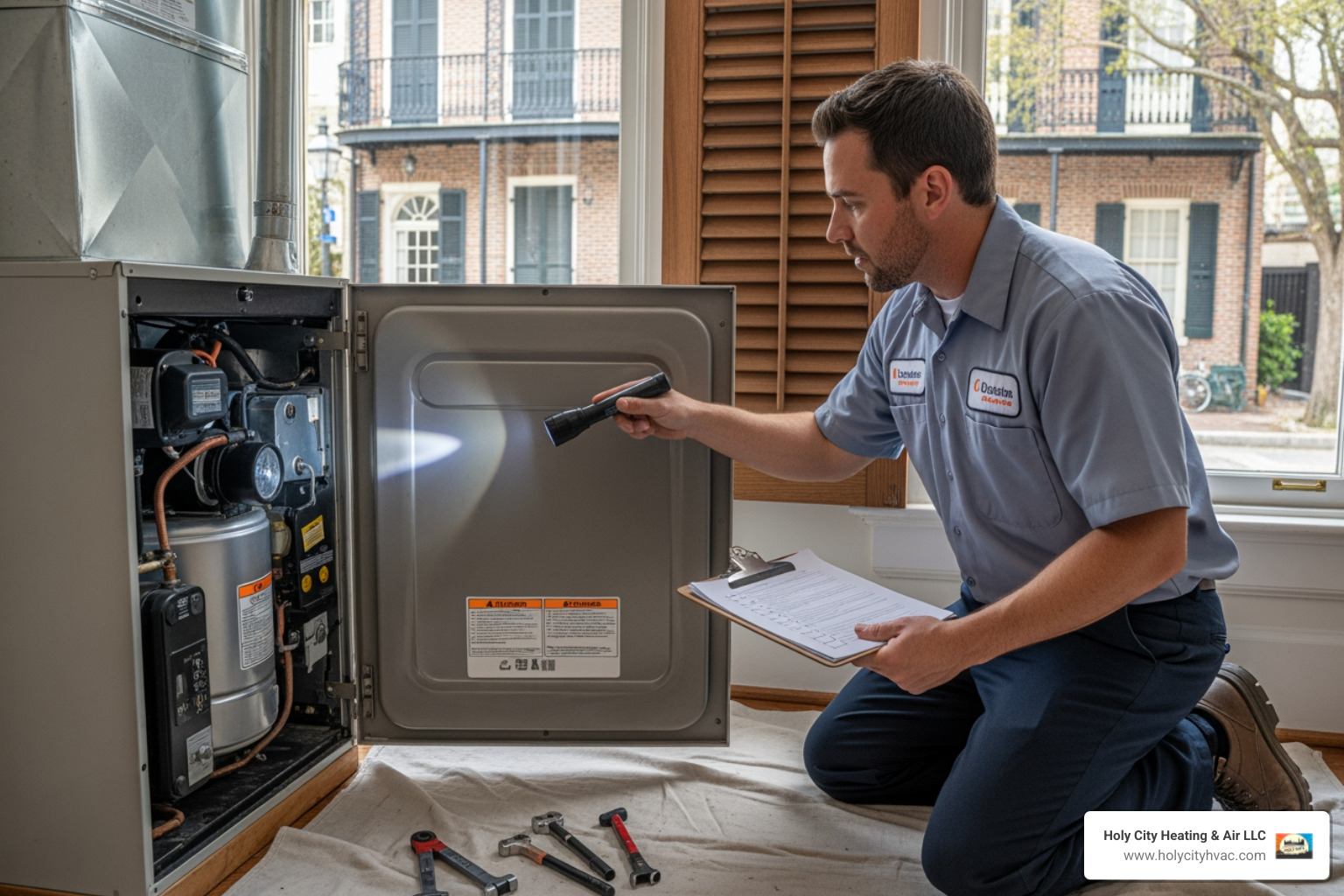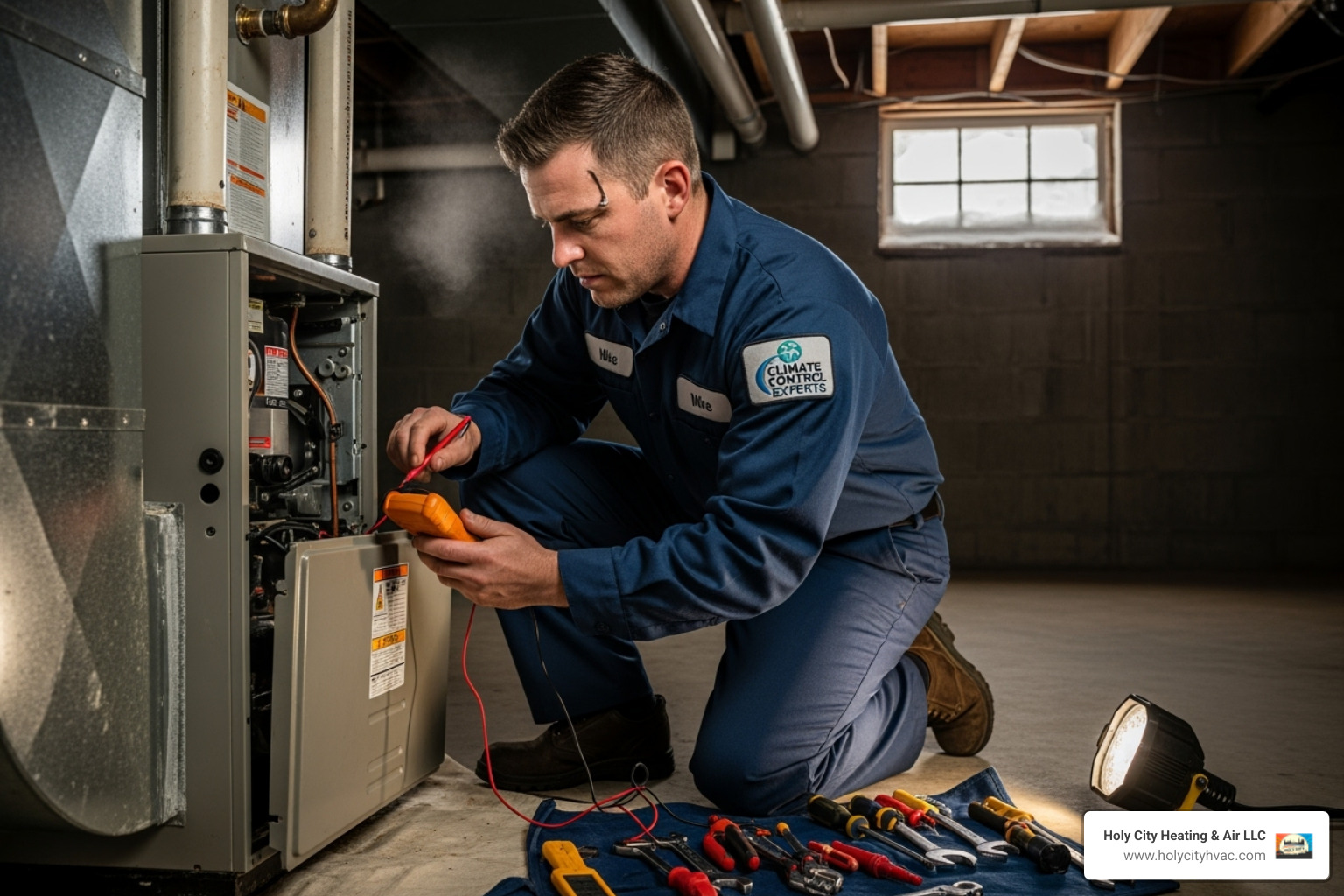
Why Adding Central Air is a Game-Changer for Charleston Homeowners
Adding central air to your house is one of the most impactful comfort upgrades you can make. Charleston's hot, humid summers make central air essential for year-round comfort.
Quick Answer: Adding Central Air to Your Home
- Cost Range: $5,000-$12,000 for most homes (varies by size and existing ductwork)
- Installation Time: 1-3 days depending on complexity
- Main Components: Outdoor condenser unit, indoor evaporator coil, ductwork, thermostat
- Key Requirements: Professional installation, proper electrical supply, permits
- Best For: Whole-home comfort, improved air quality, increased home value
Central air keeps temperatures steady, reduces humidity, and filters air throughout your home, providing consistent comfort in every space—unlike window units. Installation connects an outdoor condenser to an indoor evaporator coil. If your home has ductwork from a furnace, the process is simpler and less expensive. Homes without ducts require new ductwork, which increases cost and time.
Installing central air can add 5-7% to your home's value while dramatically improving your family's comfort during Charleston's sweltering summer months.

Understanding the Costs: What to Budget for Central Air
When you're ready to add central air to house, understanding the investment is key. Cost is a primary concern for Charleston homeowners, and we aim to provide a realistic overview.
Total installation cost typically ranges from several thousand to over ten thousand dollars, depending on your home's needs. This range reflects variables like the unit, professional installation, permits, and any necessary modifications.
Our pre-installation evaluation includes a Manual J load calculation to determine your home's exact cooling needs. We also secure all necessary permits, ensuring your installation meets safety and building codes to protect your investment and family.
For our Charleston area customers, you can learn more about our comprehensive approach on our AC Installation Charleston SC page.
Key Factors Influencing Your Final Price
Several factors determine the final cost to add central air to house.
Your home's size is a major factor. Larger homes need bigger, more expensive units. We calculate the right size to ensure proper cooling without overpaying.
The condition of your existing ductwork has the biggest impact on your investment. Homes with well-maintained ducts from a heating system are ideal. Homes without ducts or with leaky ones require additional work, increasing the cost.
The type of AC unit you choose affects cost and performance. Split systems are most common. Packaged units suit homes with limited indoor space. Heat pumps offer both heating and cooling.
Energy efficiency ratings influence initial cost and savings. Higher SEER (Seasonal Energy Efficiency Ratio) units cost more upfront but lower your energy bills. We help balance initial cost with long-term savings.
Your home's layout and complexity can impact labor. Complex layouts, like multi-story homes or tight attics, may require more labor. Our experienced team expertly handles challenges in historic Charleston homes.
Regional labor rates and local building requirements also factor into your total cost. Charleston's competitive market helps keep labor costs reasonable.

The Role of Ductwork in Your Budget
Ductwork is a major budget factor when you add central air to house. Existing ducts from a forced-air heating system simplify installation, keeping costs down.
Homes without ducts require new ductwork installation, a significant project, especially in older Charleston homes with challenging access. Existing ducts may still need modifications. Old, leaky, or undersized ducts waste energy and reduce performance. We inspect ducts during our assessment to identify necessary repairs.
Repairing existing ducts is often a cost-effective option. We discuss all possibilities, explaining the pros and cons of each.
You can learn more about our thorough installation process on our AC Installation Process page.
How to Control Installation Costs
Here are proven strategies to manage the cost of a quality central air installation.
Taking advantage of rebates and tax credits can reduce your out-of-pocket expense. Utility rebates and federal tax credits for energy-efficient systems can lower your cost. We help you find and apply for available incentives. The Energy Star rebate finder is an excellent resource.
Timing your installation strategically can lead to better pricing. Scheduling your installation during the spring or fall can lead to better pricing and flexibility, avoiding peak summer demand.
Getting multiple quotes is wise. Ensure each estimate includes detailed breakdowns and a proper load calculation, as the cheapest option isn't always the best value.
Exploring financing options makes central air more accessible. We offer flexible financing for HVAC installations. Home equity or personal loans are other options. The key is finding terms that fit your budget.
Considering alternative system types might save money. For homes without ductwork, ductless mini-splits can be a cost-effective alternative to installing a traditional central air system with new ducts, providing excellent comfort.
Choosing the Right System for Your Home
When you add central air to house, you have several system options. We'll help you choose the right one for your needs and budget.
Split systems are the most common. They have an outdoor unit connected to an indoor unit (often with your furnace) and are efficient, reliable, and ideal for homes with existing ductwork.
Packaged units contain all components in one outdoor unit, making them perfect for homes with limited indoor space.
Ductless mini-splits are not technically central air but are a great alternative for homes without ducts. They offer highly efficient, room-by-room zoned cooling.
Geothermal systems are a premium option using the earth's stable temperature for heating and cooling. The upfront investment is high, but they offer exceptional long-term energy savings.
Each system has its sweet spot depending on your home's unique situation. For more detailed information, check out our guide on Choosing the Best AC Unit.
How to add central air to house with the right size unit
Properly sizing the unit when you add central air to house is critical and more complex than just using square footage. Sizing with outdated "rules of thumb" leads to problems.
An undersized unit runs constantly without success, leading to high bills and premature wear. An oversized unit short-cycles (turns on and off too often), wasting energy, causing temperature swings, and failing to dehumidify, leaving your home feeling clammy.
BTUs (British Thermal Units) measure cooling capacity (1.5 to 5 tons for residential units), but proper sizing depends on more than just square footage. That's why we perform a Manual J load calculation for every installation. This comprehensive assessment considers insulation, windows, sun exposure, climate, occupancy, and appliances to determine your home's exact cooling needs.
We follow the Professional sizing standards from the Air Conditioning Contractors of America to ensure our calculations are spot-on. This meticulous approach means you get a system that's perfectly matched to your home's unique characteristics.

Understanding SEER Ratings for Efficiency and Savings
When you add central air to house, the SEER (Seasonal Energy Efficiency Ratio) rating is your guide to energy savings. Like MPG for a car, a higher SEER means better efficiency.
As of 2023, new SEER2 standards require higher efficiency. In South Carolina, new systems must meet a minimum of 15 SEER2, a major improvement over older units.
Replacing an old 9 SEER system with a 15 SEER2 unit can cut cooling bills by 35% or more. While high-efficiency models have a higher upfront cost, the monthly savings add up quickly.
We help you balance upfront cost and long-term savings. In Charleston's hot climate, a higher SEER unit's initial cost is often offset by significant monthly savings. We'll walk you through the numbers so you can make an informed decision that fits your budget and comfort goals. You can review the Federal energy efficiency requirements for more technical details.
The Step-by-Step Process to add central air to house
When you're ready to add central air to house, our refined process will transform your home's comfort. We'll guide you through each step.
The process takes one to three days, depending on complexity and ductwork needs. We've designed our approach to be as smooth and stress-free as possible. You can learn more about how we prioritize your comfort in our AC Installation for Home Comfort guide.
Step 1: Professional Consultation and Home Assessment
Our process begins with a comprehensive home consultation by our EPA-certified professionals. During the site evaluation, we discuss your comfort concerns and goals to understand your needs.
A ductwork inspection is critical. We examine existing ducts for leaks, sizing, and condition, identifying any needed repairs for optimal performance.
Next, we perform a detailed Manual J load calculation. This engineering assessment considers insulation, windows, sun exposure, and more to ensure your system is sized for efficiency and comfort.
We then help you choose the right equipment, explaining all options clearly. You'll receive a transparent, detailed quote with a full cost breakdown.
For helpful questions to ask during this phase, check out our guide on 5 Questions to Ask When Choosing a New AC Unit.
Step 2: Preparing Your Home for Installation
After you've chosen your system, a few preparation steps ensure a smooth installation day.
Clearing space around the indoor and outdoor unit locations and access paths helps our team work safely and efficiently.
Your new system requires a dedicated circuit, so some homes need electrical upgrades. We coordinate with licensed electricians to ensure all work meets safety codes for optimal performance.
We handle permit acquisition, securing all necessary permits from your local municipality to ensure your installation is fully compliant with building codes.

Step 3: The Installation Day(s)
On installation day, our licensed professionals arrive ready to transform your home's comfort with minimal disruption.
The process includes: placing the outdoor condenser on a prepared pad, considering airflow and noise; installing the indoor evaporator coil, typically with your furnace or in an attic/basement; precisely connecting refrigerant lines for maximum efficiency; handling all electrical wiring to a dedicated circuit; and setting up the condensate drain system. If new ductwork is required, we install it; otherwise, we integrate the new coil with your existing ducts.
Finally, we perform thorough testing and calibration, checking refrigerant levels, electrical connections, and airflow to ensure quiet, efficient operation. We'll then walk you through your new system and answer any questions.
Life After Installation: Benefits and Long-Term Care
When you add central air to house, the immediate comfort is just the beginning. Your home's value can increase by 5-7%. More importantly, indoor air quality improves as the system filters dust and pollen, and consistent dehumidification eliminates that sticky, clammy feeling. You'll enjoy whole-home comfort with consistent temperatures in every room, all controlled by a single thermostat.
Like any major system, your central air needs regular care to perform at its best. Maintenance protects your investment. Our team at Air Conditioning Maintenance Charleston SC makes it easy to keep your system running smoothly year after year.
The Pros and Cons of Adding Central Air
It's important to understand both the pros and cons of this investment:
| Pros | Cons |
|---|---|
| Even Cooling: Consistent temperatures throughout your entire home. | High Initial Cost: Significant upfront investment. |
| Dehumidification: Reduces indoor humidity, making your home feel cooler and more comfortable. | Installation Disruption: Can involve cutting into walls/ceilings, especially for new ductwork. |
| Higher Home Value: Can add 5-7% to your home's resale value and make it sell faster. | Ongoing Maintenance: Requires regular professional tune-ups and filter changes. |
| Better Air Filtration: Filters remove dust, pollen, and other airborne particles, improving indoor air quality. | Energy Consumption: While efficient, it still consumes electricity. |
| Quiet Operation: Most mechanical operations are outside or in a dedicated utility space, making indoor areas quieter. | Ductwork Requirements: Traditional central air needs extensive ductwork, which may not exist in older homes. |
| Convenience: Single thermostat control for whole-home comfort. |
The convenience factor is a major benefit. A single thermostat replaces the hassle of window units and multiple remotes.
How long does a central air system last?
Most well-maintained central air systems last 15 to 20 years, providing decades of reliable cooling.
Unit quality is key to longevity. We partner with Daikin for their durable, well-warrantied systems, ensuring years of worry-free operation.
Professional installation is critical to longevity. Improper sizing or installation leads to premature failure. Our technicians ensure everything is done to manufacturer specifications.
Regular maintenance is the best way to maximize your system's lifespan. Annual tune-ups catch small issues before they become costly problems by allowing us to clean coils, check refrigerant, and inspect connections.
Changing air filters every 1-3 months is a simple, effective task. Clean filters improve airflow, lower energy bills, and reduce wear on your system.
Take care of your central air system, and it'll take care of your family's comfort for many years to come. For guidance on avoiding common problems that can shorten your system's life, check out our tips on AC Repair Issues and How to Prevent Them.
Frequently Asked Questions about Adding Central Air
Here are answers to the most common questions we get from Charleston homeowners about adding central air.
Can you add central air to an older home without existing ducts?
Yes, this is a common scenario in Charleston's older homes. We have several proven solutions.
New ductwork installation is the most comprehensive option. We design a system for your home's layout, running ducts through attics, basements, or closets to provide true whole-home comfort.
Ductless mini-split systems are a great alternative when ductwork isn't practical. They offer excellent zoned cooling, allowing you to cool only the rooms you're using.
High-velocity systems use small, flexible tubes instead of large ducts, making them ideal for historic homes with minimal disruption.
The cost is higher without existing ductwork, but we'll review all options to find the best fit for your home and budget.
Is it cheaper to install central air or a mini-split system?
The answer depends on your home's existing infrastructure.
For homes with existing ductwork, traditional central air is usually cheaper because the distribution system is already in place.
For homes without ductwork, a multi-zone mini-split system is often more budget-friendly than installing a new duct system. You also gain the energy-saving benefits of zoned cooling.
We evaluate each home to recommend the solution with the best comfort and value.
Can I install central air myself?
While we admire the DIY spirit, installing central air is a job for professionals.
Refrigerant handling is dangerous and requires EPA certification by law due to strict environmental regulations.
The electrical work involves dedicated high-voltage circuits. Improper wiring is a serious safety risk.
Most manufacturers void warranties on systems that are not professionally installed, leaving you without coverage for future repairs.
There are other safety risks involving heavy equipment and sharp materials that our trained team is equipped to handle.
An improperly installed system will be inefficient and prone to early failure. Professional installation saves money in the long run by ensuring efficiency, reliability, and a valid warranty.
We're here to make the whole process smooth and stress-free for you. For more insight into why this matters so much, check out our article on the Importance of Professional AC Installation Services.
Conclusion
Deciding to add central air to house is one of the smartest investments for your Charleston home. You're investing in your family's daily comfort, better air quality, and increased property value.
The path to whole-home comfort requires careful planning and expert execution. While it may seem complex, having the right professional team makes all the difference.
Professional installation is crucial to get the most from your investment. A properly sized and installed system will provide reliable comfort for 15-20 years, reducing humidity and filtering your air.
At Holy City Heating & Air, we've been helping Charleston families stay comfortable since 2015. As a family-owned company with over 20 years of industry expertise, we understand what it means to create a true home sanctuary. Our EPA-certified, licensed professionals don't just install equipment – we deliver peace of mind.
We combine the resources and reliability of a growing company with the personal touch you'd expect from your neighbors. When you choose us, you're getting comprehensive Daikin warranties, the Daikin Comfort Promise, and a team that's genuinely invested in your long-term comfort and satisfaction.
Your home should be your refuge from Charleston's heat and humidity. Ready to enjoy whole-home comfort? Learn more about our expert air conditioning services and find how we can transform your house into the cool, comfortable home you deserve.
Recent posts


















